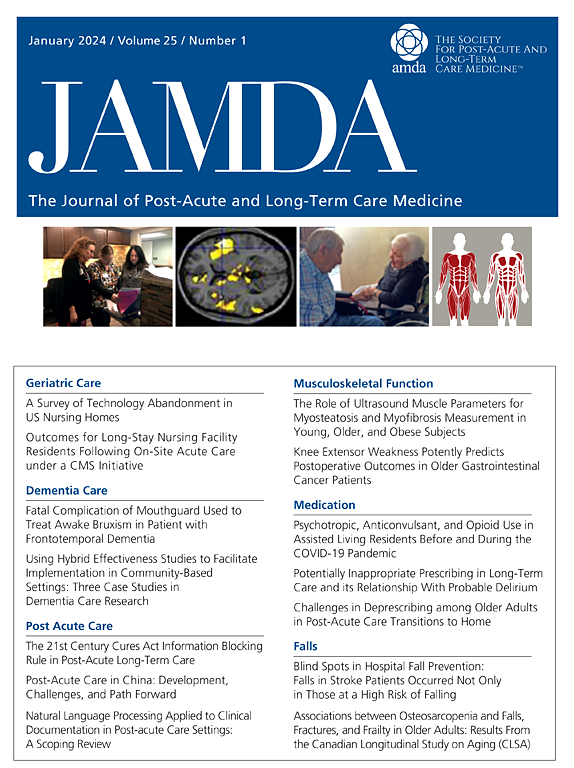脆性骨折综合康复管理对髋部骨折老年人的疗效:随访 1 年的随机对照试验。
IF 4.2
2区 医学
Q2 GERIATRICS & GERONTOLOGY
Journal of the American Medical Directors Association
Pub Date : 2024-10-22
DOI:10.1016/j.jamda.2024.105321
引用次数: 0
摘要
目的:事实证明,综合性多学科康复治疗对髋部骨折手术后的康复患者有益,可提高术后疗效。然而,由于医疗保健系统的局限性和政策的不完善,提供此类康复服务仍面临挑战。本研究旨在评估髋部骨折术后脆性骨折综合康复管理(FIRM)与传统康复方法相比的临床效果:设计:平行组、单盲、多中心随机临床试验:环境和参与者:三个院内康复机构;203 名 65 岁及以上的髋部骨折手术患者被随机选中并随访 1 年:主要结果采用科瓦尔量表和功能性行走分类(FAC)量表评估行走功能。在康复入院、出院以及术后 3、6 和 12 个月的随访期间对功能结果进行评估。对每个随访时间点的独立行走率和恢复到骨折前行走状态的情况进行了分析:结果:在为期一年的随访中,FIRM 组的 Koval 和 FAC 评分以及大多数次要结果均有明显改善。从基线到 12 个月,Koval 评分(平均差异为 -4.13 [95% CI, -4.56 to -3.70] vs -3.22 [95% CI, -3.86 to -2.61],P = .016)和 FAC 评分(平均差异为 3.37 [95% CI, 3.01 to 3.72] vs 2.56 [95% CI, 2.10 to 3.02],P = .006)均有显著变化。在 12 个月的随访中,该组的独立行走率(53 [76.8%] vs 28 [56.0%],P = .016)和恢复到骨折前行走状态的比率(56 [81.2%] vs 31 [62.0%],P = .020)也高于常规组:与传统康复方法相比,FIRM 在改善髋部骨折老年人的行动能力和其他功能结果方面表现出更高的有效性。这一发现为韩国及其他国家管理髋部骨折术后多学科综合护理提供了宝贵的见解。本文章由计算机程序翻译,如有差异,请以英文原文为准。
Efficacy of Fragility Fracture Integrated Rehabilitation Management in Older Adults With Hip Fractures: A Randomized Controlled Trial With 1-Year Follow-Up
Objectives
Comprehensive multidisciplinary rehabilitation has been proven to benefit patients recovering from hip fracture surgery, enhancing postoperative outcomes. However, challenges persist in delivering such rehabilitation due to health care system limitations and inadequate policies. This study aimed to evaluate the clinical effectiveness of Fragility Fracture Integrated Rehabilitation Management (FIRM) in comparison to a conventional rehabilitation after hip fracture surgery.
Design
A parallel-group, single-blind, multicenter randomized clinical trial.
Setting and Participants
Three in-hospital rehabilitation settings; 203 hip fracture surgery patients aged 65 years and older were randomized and followed up for 1 year.
Methods
The main outcome assessed ambulatory function, using the Koval and Functional Ambulation Category (FAC) scales. Functional outcomes were evaluated upon rehabilitation admission, discharge, and during follow-up at 3, 6, and 12 months post-surgery. The prevalence of independent ambulation and recovery to prefracture ambulatory status at each follow-up time point were analyzed.
Results
The FIRM group demonstrated superior improvements in Koval and FAC scores, along with most secondary outcomes during the 1-year follow-up. Significant changes from baseline to 12 months were observed in Koval scores [mean difference, −4.13 (95% CI, −4.56 to −3.70) vs −3.22 (95% CI, −3.86 to −2.61), P = .016] and FAC scores [mean difference, 3.37 (95% CI, 3.01 to 3.72) vs 2.56 (95% CI, 2.10 to 3.02), P = .006]. At the 12-month follow-up point, this group also showed higher rates of independent ambulation [53 (76.8%) vs 28 (56.0%), P = .016] and recovery to prefracture ambulatory status [56 (81.2%) vs 31 (62.0%), P = .020] than the conventional group.
Conclusions and Implications
The FIRM demonstrated superior effectiveness compared with conventional rehabilitation in improving ambulation and other functional outcomes in older adults with hip fracture. This finding provides valuable insights for managing comprehensive multidisciplinary postoperative care for hip fractures in South Korea and beyond.
求助全文
通过发布文献求助,成功后即可免费获取论文全文。
去求助
来源期刊
CiteScore
11.10
自引率
6.60%
发文量
472
审稿时长
44 days
期刊介绍:
JAMDA, the official journal of AMDA - The Society for Post-Acute and Long-Term Care Medicine, is a leading peer-reviewed publication that offers practical information and research geared towards healthcare professionals in the post-acute and long-term care fields. It is also a valuable resource for policy-makers, organizational leaders, educators, and advocates.
The journal provides essential information for various healthcare professionals such as medical directors, attending physicians, nurses, consultant pharmacists, geriatric psychiatrists, nurse practitioners, physician assistants, physical and occupational therapists, social workers, and others involved in providing, overseeing, and promoting quality

 求助内容:
求助内容: 应助结果提醒方式:
应助结果提醒方式:


